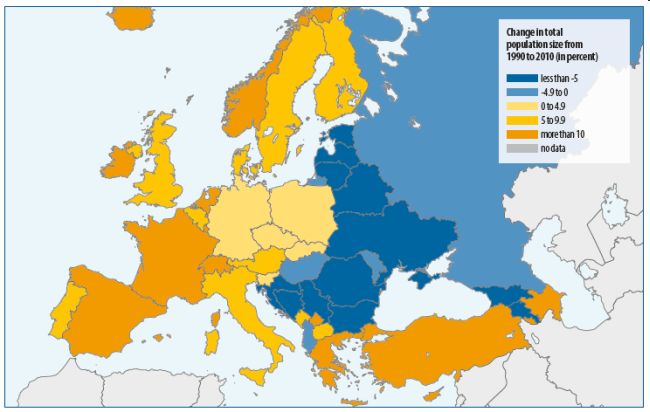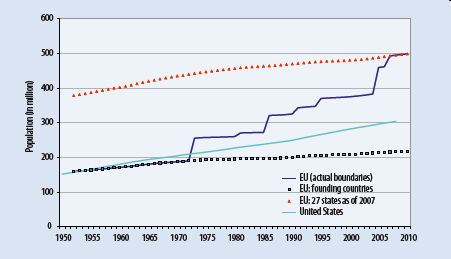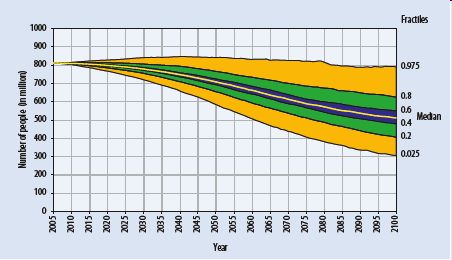European Union reaches 500 Million
Like any other population, the population of the European Union (EU) changes as a consequence of the interplay of three factors: fertility (births), mortality (deaths) and the balance of in- and out-migration. In addition, the EU has a further source of population growth through the accessions of new member states as it occurred in 1973, 1981, 1986, 1990 (incorporation of East Germany), 1995, 2004 and 2007. Since the beginning of the post-war integration process in Europe, marked by the foundation of the European Coal and Steel Community in 1952, the population of the EU has more than tripled from 160 million to 500 million. The enlargement process was in fact the main reason for this remarkable population growth, with the population of the six founding members (Belgium, France, Germany, Italy, Luxembourg and the Netherlands) increasing ‘only’ to 218 million in 2009 (Figure 2).
The 500-million mark was reached in the present-day EU of 27 countries (excluding French overseas territories) during the first half of 2010. During the last three years, 2007–09, the balance of births and deaths was slightly positive for all 27 countries taken together, but somewhat negative for the twelve recent accession countries that joined the EU in 2004 and 2007 (see more details on the reverse side). However, the more important growth factor over the past three years was the significant net migration gain from countries outside the EU. National differentials in migration patterns are also the main reason why over the past two decades countries in the West of the continent tended to grow while those in the East showed declining population sizes (see Figure 1).


Uncertainties about the most recent trends in migration are also the primary reason why it is not possible to precisely determine the date when the 500-million mark was reached. Due to the recent economic crisis, net migration gains fell in many countries and projections based on previous levels are most likely too high. A more precise picture will only be available after the current round of population censuses in Europe has been analysed, probably in 2012. When this is finished, we will be able to estimate the ‘500-million day’ with higher precision.
Figure 2 depicts the growth of the EU population since the 1950s and compares it to that of the United States of America. It shows that in 1954 the total population of the founding member countries of today’s EU exactly equalled that of the USA, both having populations of 163 million. Since then the population of the USA has grown consistently more rapidly than that of the EU founding members and reached 300 million in 2007, a fact that was widely discussed in the American and international media. But the figure also shows the different steps of EU expansion which brought the total population of the EU far above that of the USA.
Over the coming decades, the population of the EU-27 as a whole is expected to continue growing although from around 2015 onwards deaths are likely to outnumber births. Hence the subsequent population growth is expected to come entirely from future migration gains originating from countries outside the EU. Assuming rather stable migration patterns as observed over the past years with a slowly declining tendency still results in an increase of the EU population to around 528 million by 2030.
In thinking about the future we have to be aware that such projections are associated with great uncertainties. Migration flows are the most volatile component of population change and the migration consequences of the current economic crisis clearly illustrate this point. But in the longer run the uncertainties associated with future fertility and mortality trends also lead to significant uncertainty ranges in future population sizes. While most traditional population projections—such as the high, medium and low variants published by the United Nations—only project the uncertainties derived from three different assumptions on fertility trends, probabilistic population projections can depict the uncertainty in total population size resulting from a combination of the uncertainties of future fertility, mortality and migration paths. Such probabilistic projections are carried out by running thousands of independent simulations based on different fertility, mortality and migration assumptions. As a result they provide predicted distributions of future population sizes.
Going beyond the EU to all 48 European countries included in this data sheet (thus embracing Turkey, all of Russia as well as the Caucasus countries), Figure 3 shows a probabilistic population projection for Europe until the end of this century.1 The yellow line at the centre gives the median with one-half of the simulated cases above and the other one-half below. The orange areas give the 95 per cent range which opens up the more one goes into the future. While the total European population is currently slightly above 800 million, it is expected to start declining slowly over the next decades, with the median at around 700 million in 2050. During the second half of the century the decline accelerates, with the median showing a fall of the total European population to around half a billion, comparable to the EU population today. But the uncertainty range of this projection is considerable, depending primarily on uncertain future fertility and migration trends. This shrinking of Europe’s population will initially happen in the context of a growing world population, although we expect an end of world population growth during the second half the century.2 These combined trends will result in a significant decline of the share of Europe’s population in the total world population from currently 12 percent to around 8 percent by the middle of the century, and further to only 5–7 percent toward the end of the century (see Figure 4).


50 years ago the six founding members of the EU comprised about 6 percent of the world population of that day. At present the EU-27 has 7.3 percent of the current world population of 6.9 billion. 50 years from now, in 2060, the population of all of Europe will also be around 7.3 percent of the world population. But the share of the population of the current EU will fall to around 5.7 percent—unless it continues to grow through further accessions.
1 Lutz, W., W. Sanderson and S. Scherbov. 2008. The coming acceleration of global population ageing. Nature 451: 716-719.
2 Lutz, W., W. Sanderson and S. Scherbov. 2001. The end of world population growth. Nature 412: 543-545.